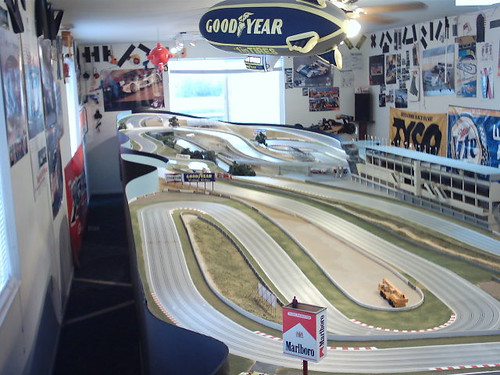
It would be a waste if a top-grade slot car is not properly cared for. In the sport of slot car racing, proper maintenance and effective improvisation almost always determine the victor. If you are going to spend a lot of money on quality slot cars, like the micro scalextric cars, you want to take care of your car. And if you're serious about being competitive in slot car racing, it'd do you well to heed the tips that are going to be discussed in this article.
1. Keep Your Slot Car Clean
Slot cars can accumulate dust and dirt in its nooks and crannies, which can cause congestion on the wheel hubs, axles, and pick up shoes. If not properly cleaned, these components will have a hard time to rotate freely.
What you should do is remove the body and make sure that the chassis is clean. The moving parts amount to tires, gears, axles, springs and motors. Rotate them and determine if they can move without difficulty. In case there are parts that are worn out, replacing them is the smarter thing to do. As long as all these components are working properly, the slot car will perform better and last longer.
2. Apply Lubrication
Cleaning is simply not enough. Even a clean car will have difficulties in maintaining a solid run if friction is left alone to do its nasty work. To avoid this problem, make sure to lubricate the slot car chassis and the motor. A small drop of oil on each of the chassis axle bearings is a good insurance policy as far as keeping the axles spinning without any interruptions is concerned. Do the same procedure for the front and rear end bells to make sure that the armatures can spin without difficulty. Remember, a small drop on each component will do; otherwise, the operation could become messy.
3. Stick to One Car
You have to choose a slot car that works for you. In case you have a lot of slot cars to choose from, do a test drive on each one and choose the one you can handle best. If you think that some tweaks have to be made, feel free to do so and do a test run again.
4. Practice Makes Perfect
Once you're finished choosing your "baby", you need to do regular drills in order for you to have a better "feel" for all the little but important nuances that are involved in handling the slot car. Believe it or not, each slot car is unique. And funny as it may sound, each one seems to develop its own set of characteristics.
So treat your slot car like a prizefighter. Do a test drive for a few hours each day. Try different types of tracks. If you spot a weakness, do the necessary adjustments and then give it another try. With plenty of time, you can spot subtleties more effectively and know exactly what you need to do with each one.
These are the basic guidelines to ensure that you and your slot car remain competitive in the slot car racing arena. Slot cars are curious things, but if you are familiar with all the little things, you are well on your way to making it big in the sport of slot car racing.
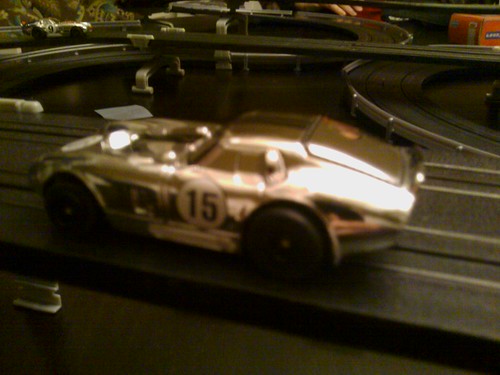 Slot cars come off the production line with the best setting and performance according to its capacity. This is not to say though that you, as the driver, can't add some changes to the original product to optimize its performance.
Slot cars come off the production line with the best setting and performance according to its capacity. This is not to say though that you, as the driver, can't add some changes to the original product to optimize its performance.
Most cars won't perform their best when raced straight out of the box. They are just not competitive enough for racing against other cars that have received some modifications. Fine-tuning is very much needed to shake off the mass production settings of the car.
Braids The original braids of slot cars are often too small for good performance. A little push to keep them apart will do the trick of allowing them closer contact to the rail. For better performance, exchange the original braids with softer ones to reduce friction and enhance electrical conductivity. Always do routine maintenance to the braids to keep them free of dirt.
Rims and Tires Slot cars are molded from plastic and as such, are likely to have burrs in some areas which could affect the performance of the car. Remove all burrs as much as possible. Remove, especially, the burrs on each wheel and polish the rim to make it completely round.
To do this, remove each wheel and give the rim a more round profile. Put back the wheels and run the car on sandpaper for a few seconds. This process, called 'truing the tires', should polish the entire circumference of each wheel. For further polishing, you can soak the wheels with oil to soften the rubber.
Clean the tires. Use light fuel to rub the entire with a clean sheet to remove dirt. You can do this for routine maintenance and every after race to keep the tires free from dirt.
Some people glue the tires to the rim to prevent these from spinning. You can do this if you don’t want the axles of your car's wheels to move during the race.
Cleaning Routine maintenance is a key component of keeping the car's performance at its best. After each race, cars get dirty. This is especially true if you are racing on simulated rally courses that use either cocoa powder or flour to substitute for dirt or snow.
Check the entire car for dirt, especially the interior or chassis. Check the chassis for dust and dirt and wipe these out.
Motor Serious attention should be given to the car's motor. Needless to say, the motor should always be clean and well maintained.
Prior to the race, most racers make it a habit to warm up the motor before putting the car on the track. This should take more or less a few hours to complete. When doing this, be sure to gradually increase the voltage to ensure that the car gets the power it needs to perform well.
To prevent wear and tear, most racers attach the motor to the chassis permanently. Do this by either gluing the motor to the chassis or by taping it.
Chassis Just like real racecars, the chassis of any slot car should be optimized for performance. Sanding the sides of the car as well as loosening the screws will do the trick.
The types of slot cars available in the market these days are basically divided into the limitations that technology imposes on the make of the car. One is the good old system of conventional slot cars and the other is the new form of racing presented by digital slot cars.
Conventional Slot Cars Conventional slot cars are actually fashioned from the traditional system racing slot cars – racing electric-powered cars on wooden or plastic tracks. This type of cars has a motor that is directly connected to the guide that is attached to the chassis of the model. This guide is then hinged to one of the parallel rails on the racetrack which acts to keep the cars in place no matter the speed. The car gets its speed from the hand-held controller which determines the amount of power that is supplied to the model.
Each conventional car races only in one lane and is not capable of changing lanes during the race. Thus, if there are only 4 lanes in a track, there can only be 4 cars that will race. To compensate for the limitations and disadvantages of racing in just one lane, races are divided into heats which allow the drivers to switch between lanes to equalize any factor that could make one lane disadvantageous for racing.
Digital Slot Cars Digital slot cars are the newer car models in the market. These basically pick up from where the traditional slot cars left off. Unlike its older counterpart, digital slot cars allow for simultaneous racing on as few as two lanes per race – much like as you would see with other types of car racing. Newer technologies have allowed this new form of slot cars to be less dependent on the guide that keep the old cars hinged to one side of the racetrack. The electronic circuitry of the digital models allow for drivers to have full control over the speed and movements of the car.
Generally, digital slot cars are more expensive than their older counterpart and are arguably harder to drive than the conventional models. This is because drivers of digital slot cars have to learn how to control the speed of the car as well as learn how to switch lanes without falling off of the racetrack.
On Slot Cars In General Slot cars, as you would know by now, are actually scaled-down models of actual cars. Some are just tiny mock-up models that are purposely built for miniature racing while others are made to copy all aspects of the actual models, including the actual car's capacity in terms of performance.
Most racers race with commercially available slot cars that are mass produced by such manufacturers as Scalextri, Johnny Lightning and Carrera. Most of these are modification-ready models to enhance performance. Some enthusiasts by motorize static models while hobbyists create 'scratch-build' cars that run on their own mechanism and bodies. These are often created from store-brought spare parts built to create true models of the original cars being copied.
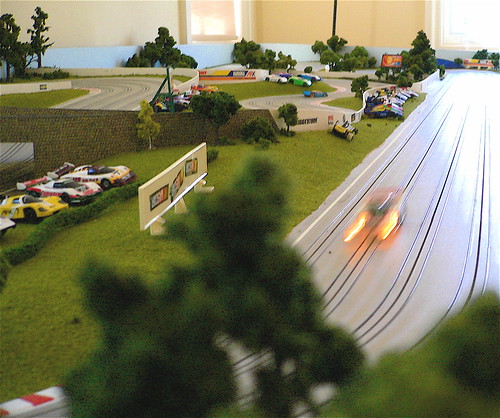
Slot car racing is a very popular hobby among miniature car racing enthusiasts. It satisfies the inner speed demons among us and is a relatively inexpensive hobby for people who love building model cars. In this article, we will provide you with information that can help you not only save on buying slot cars and slot car accessories but also buying advices that will allow you to make the best choice:
Which slot car scale? There are 1 32 slot cars, 1 24 slot cars, HO slot cars and more.
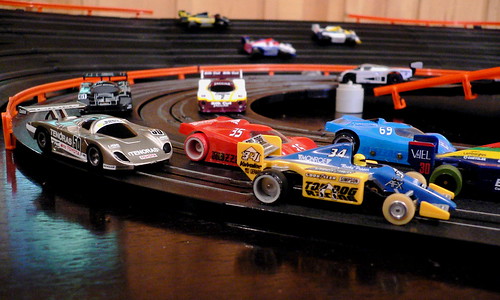
Slot cars come in various scales and each scale has its own pros and cons. The larger scales, for example, have superb detailing and are often geared to perform according to the performance specs of the original cars they were modeled from. These are usually raced in competitions and are often considered among the cars worth collecting.
The main disadvantage of using the 1:24 scale, the largest there is, is that this takes so much space. The same is quite true with the smaller 1:32 scale. For a decent basic racetrack, you should at least have an 8 by 6 feet racetrack.
The space needed to accommodate the racetrack for larger scales is always a major consideration. If you have a small space available for your racetrack, it is often more advisable to stick with smaller scales, like the HO scale.
The HO scale is where the smallest of slot cars are categorized under. This includes small cars whose size ranges from 2 ½ inches to 3 ½ inches.
Now, when it comes to buying, it is very important to first check how much space you have for your toys. If you don’t think larger scales are good for you, it is advisable that you settle with the smaller ones. Also, if there are no race circuits for 1:24 and 1:32 slot cars near you, you should stick with smaller scales.
Which manufacturer? There are literally hundreds of companies that produce competition-ready slot cars for hardcore slot car racing enthusiasts to slot car toys for children. Obviously, you should look for those companies that produce high quality slot cars whose performance is optimized for racing. Among the most common manufacturers are Artin, Johnny Lightning, Carrera, Fly, Ninco, Monogram, and Scalextric. These differ in the quality of cars they produce as well as the price range. The most affordable cars are produced by Artin and the manufacturers that are known for winning the most race are Scalextric, Carrera and Johnny Lighting for individual scales. The high-end slot cars are produced by Fly.
Where to buy? Slot car shops can be found in brick and mortar shops as well as online shops. eBay, a very popular worldwide online bidding site, is where many slot car hobbyists and enthusiasts go for their supplies. Individual online vendors are also some of the best places to visit online to get your car sets. It is also a good idea to check out hobby shops near you.
How to buy? It doesn’t matter where you buy; what matters is how you buy. Slot cars command relatively inexpensive price tags although there are some well-made ones that could cost you a fortune. So do your research first before you buy your own car. It is important to know everything about the car first before you pay some serious money for it.
Does your kid love racing? To make him experience the joy and excitement of being on a race track without actually driving a real race car, you should think of buying him a slot car set. AFX Slot cars are replicas of actual automobiles with bodies made purposely for miniature racing. While there are commercially available slot cars of different sizes and styles, some racers still prefer to make their own models from basic parts and materials. But how and where did slot cars originated?

The first slot cars to hit the market were built by Lionel Corporation. This model, which appeared on Lionel's catalog in 1912, draws it power from a toy train rail that was set in the wide slot between the rails. Racers can adjust the speed of their vehicle by regulating the switch positioned on the track's power supply. This very first model has much resemblance to modern slot cars, but independent speed control was offered only as an option way back then. Production of this toy set was stopped after 1915.
1930s In late 1930s, hobbyist use relatively large model cars with 1:16 to 1:18 scales. These cars derived their power from miniature internal combustion engines that were initially equipped with spark-ignition that was later on replaced with glow plug engines. Since there was no way for the player to control the car's speed and steering, this kind of car was mainly a mechanic's hobby.
1940s In 1940s, British hobbyists start experimenting controllable electric cars that feature hand-built motors.
1950s In 1954, the Southport model Engineering Society in the United Kingdom was dared by a patent-holder to use rail-guided gas-car exhibition on raising funds. So its staff made an electric racecourse with six-lane layout and measuring 60 feet long. This course is designed for 1:32 rail-guided cars which are considered as the ancestors of slot racing cars.
Inspired by the said layout from Southport, some US and UK clubs start racing electric cars assisted by center rails in 1955 to 1956. These rails were soon after replaced by slots on the track surface and cars raced on these tracks are name slot cars. In 1957, Minimodels has produced a famous line of slot-guided vehicles called Scalextric. Victory Industries also launched the VIP line. The Scaletrix became an instant hit, causing engineers and some companies like Aurora Plastics Corporation to develop HO vibrator sets. These small cars amazed the public because their price and size best suit the needs of average consumers.
1960s It was in the 1960s when slot cars became very much popular. In 1963, after manufacturing a million and a half units, Aurora made flat-commutator motor to replace the vibrator cars. From this, the best-selling slot car in history, called Aurora Thunderjet-500, was produced. The Thunderjets, along with their upgraded versions, dominated the market for around a decade.
1970s It was in the late 1970s when the slot car craze sputtered out.
By using computer-aided designing, more detailed and authentic models have been made in 1990s. And in 2004, the digital control systems which have modernized model railroading, start appearing in 1:32 slot cars. Such systems provide racers with the ability to race multiple cars in every lane, and to enjoy more realistic racing experience.
If you love cars and get off on speed as much as I do, you would do well to try slot car racing. In my opinion, Tyco Slot cars are the most fun, but slot cars have been popular since the late 1950s, and despite the proliferation of many other hobbies ever since, slot car racing is still very much in the mainstream. The fun factor and the customization possibilities involved in slot car racing simply give the sport an immediate appeal to many car and toy enthusiasts.
Slot car racing is an exciting prospect, sure, but being successful with it also involves a meticulous eye for detail and a propensity to mechanics. And in this article, we'll discuss the fundamentals of how slot cars work in order to steer you in the right direction.
First, what is a slot car? Quite simply, it is a miniature car that can run on a fixed track. These tracks are not different from real racetracks, except that they are in miniature form. As the term "slot" implies, a shallow groove is laid out on the full length of a track to guide the slot car as it does its rounds. This groove is formed between two metal rails that are in close proximity with each other and is responsible for keeping the slot cars in place.
Of course, speed for speed's sake is not enough to win a race. Each participant uses his own controller to administer the amount of speed needed to move past opponents and keep his car on the tracks. Anticipating sharp turns, inclines, and dives come into play here; hence, the slightest mistake can send your slot car tumbling off the tracks and cause you to lose the race.

Most slot cars have magnets installed to the front and the back since the downward force they provide can help in keeping them glued on the metal rungs. This, however, doesn't guarantee that the cars won't tumble into oblivion due to sharp turns. Most modern cars, on the other hand, use a sort of microchip to allow them to operate the same way as another car and make it possible to switch lanes at pre-determined points on the track.
Almost all components of a car can be upgraded and modified according to the owner's preferences. Before heading out on a competition, one has to investigate the particular tracks involved in order to make the necessary adjustments. For example, the speed gauge of the controller has to be toned down when the track doesn't have many sharp turns.
Lastly, a slot car track is made up of plastic segments. Each lane has two steel rails, with one of them producing the power needed to move the car and the other providing the ground. The tracks absorb power from a power supply that plugs into a wall outlet. This power sends the electric current to enable the car to move.
There's no sign that slot cars are going to lose their popularity any time soon. Slot car racing is definitely worth trying, and it's not a bad idea to go out and buy a slot car as soon as you can.

Slot cars are small replicas of automobiles designed to scale. They race along a fixed track with slot or groove. The word "slot" in the name of these automobiles is derived from those shallow grooves or channels place on the track to assist vehicles as they go through turns and twists and along straight sections. Lining these grooves are two metal rails that are separated narrowly and placed into the track to form a slot in the middle. Underside the slot car is a small blade which fits into the groove to keep the car on the right path as it runs fast around the track.
If you love speed but you didn't like the idea of risking your life in driving a real race car at incredibly high speeds, then you should purchase a slot car set. Included in such set are all the necessary components needed in setting up the race track out of the box. If you need extra track pieces, controllers, car bodies, and other additional accessories, you can purchase them too.

Cats Like Slot Cars Too!
History of Slot Cars
Slots cars first appeared in early 20th century and immediately became famous not only with children but also with youngsters and adults. Early designs are based on a raised rail which was embedded in the track and players back then don't have control over the speed of the vehicle. After some modifications, slot cars in 1930s came equipped with small internal combustion engines. As time passed by, slot cars were then powered by electrical current.
There was a move in the 1950s to improve the tracks by utilizing grooves rather than raised track. With the current flowing through the groove, the speed of the car can now be managed by using a hand-held remote control for every car running on the track. With these innovations, it became possible for several individuals to enjoy slot car racing using the same track.
Because of the refinements made on slot cars, slot car racing also became popular. More and more manufacturers start offering slot car sets with a number of cars and a track that can be enhanced using add-on kits. In 1960s, a wide variety of slot cars and track configurations appear, providing slot car racers more options to work with.
Slot Car Scales
For serious competition, there are three common slot car scales or sizes. These are: 1:24 scale, 1:32 scale, and HO. The largest cars used in slot car racing are 1:24 scale cars, which come seven to eight inches long. These cars need a large course so it's really impractical for home use.
More suitable for home race courses are the smaller 1:32 scale cars that are five to six inches long. But they are also popularly raced on commercial tracks found in clubs or in hobby shops. HO–sized slot cars, on the other hand, have different scales ranging from 1:87 to 1:64. Regardless of their sizes, these cars all run on a track with the same width. The size of a typical HO slot car is from 2.5 to 3.5 inches.
Slot car racing, by the name itself, is focused on controlling the car while on the track. The name 'slot' itself refers to the grooves in the racetrack that prevents the cars from falling off of the track. But slot car racing needs more than grooves for total control. Drivers need to have something in their hands to have full control over the acceleration, breaking and general performance of their slot car. They need the slot car controller.
Analog Slot Car Controllers Analog slot car controllers are handheld devices that distribute the desired amount of voltage to the slot car on the track. A trigger, a common part of the controller, is connected to an electrical contact that is then connected to a resistor. When this trigger is squeezed, the track sends more voltage to the car, thereby causing it to pick up speed. When released, the reverse happens and the car slows down. The resistance of the controller is measured in ohms which should be noted as changes in the resistance positively affect the response time of the car.
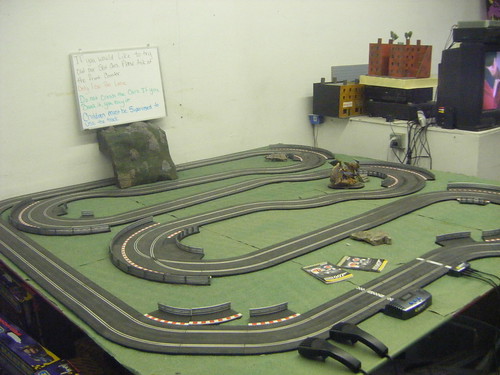
But analog slot car controllers provide more than better manageability of the voltage received by the car. Without this, drivers would have lesser ability to make turns when needed or to follow a straight path where there are long straight sections on the track.
Modifications in the extent of control controllers provide have somewhat emerged in recent years. As opposed to the older system of squeezing and releasing the trigger to speed up or slow down the car, newer controllers now provide at-the-push-of-the-button breaking system. These controllers come with an integrated button which sends negative voltage (remember the positive effect of resistance on response time?) to the slot car's electric motor. This action then causes the car to stop.
Improvements in analog slot car controllers have also paved the way for even better control on the breaking system. More advanced controllers are not equipped with a highly accurate system of controlling breaking power which lends these newer controllers a decent advantage over drivers during turns in the track.
Electronic Slot Car Controllers Electronic slot car controllers, on the other hand, pick up where their older counterparts left off. Unlike analog controllers, these do not use the same system of power delivery to the grooves on the track. Instead, these use an electronic circuit that distributes the precise voltage amount needed by the car. This also offers better car performance, improved control of the car, and better command with virtually all motor setups. These also work very well with cars that have different magnet setups.
Getting Yourself A Slot Car Controller Choosing between an analog and electric slot car controllers is basically a matter of preference. Most slot car drivers begin with analog slot car controllers. These are relatively much cheaper than electronic ones and do not require much know-how and electronic savvy. Enthusiasts, on the other hand, prefer the more complex system used in electronic slot cars.
Electronic controllers allow better power manageability and excellent breaking systems which make it very easy for drivers to control their cars on the racetrack.

Slot cars are powered small vehicles that are assisted by a slot or groove set in the tracks on which they run. At the bottom of the car is a blade or pin that keeps the car in the slot. To make the car run, the metal strips placed next to the slot deliver power to the car motor. Such power is picked up by contacts found beside the guide flag, under the front portion of the slot car. The voltage is controlled via a resistor in the hand controller.
HO slot cars operate on similar principle. The only difference is, in HO models, the current is transported through thin metal rails which are hardly seen above the track surface and are placed farther from the slot. These cars usually have electrical contacts dubbed as pick up shoes. These shoes are directly installed to the chassis and it usually uses round guide pin rather than swiveling flag.
These days, traction magnets are employed to deliver downforce, which helps hold the car in the track especially when it is running at higher speeds. There are also enthusiasts who believe that there's greater challenge in magnet-free racing.
For serious slot car racers out there, here are some tips that will help improve your slot car's speed:
1. Maintain the cleanliness of your slot. It pays a lot to keep your slot clean. You can do this by detaching the body and visually inspecting the car's chassis regularly. Pick up shoes must be clean and should float freely. Also inspect the wheel hubs to be sure they do not rub on the car's chassis. Spin the tires and see if there are bent axles. If there are any worn components, replace them long before they fail. Remember: nothing beats the performance and longevity of a clean slot car.
2. Use oil in moderation. Oil keeps the chassis and motor of your car lubricated but use only the right amount. For your chassis' axle bearings, a small drop at every bearing is sufficient enough to keep it spinning. You'll also need a drop of oil in the front and rear motor end bells to keep the armature lubricated.
3. Choose only one slot car. Avoid switching slot cars and chassis frequently. By using only one car, you can be familiar with its handling characteristics, making it easy for you to tweak it to your preference.
4. Practice. By spending more time on your chosen chassis, it will be easier for you to develop some techniques and tricks that make your car perform better than its rivals. Run your slot car on all the lanes, especially those inner lanes with very tight turns. Do this regularly. A lot of practice makes you know your chassis more as well as its exceptional characteristics. It is also through practicing that you'll be able to find out chassis and motor problems long before the serious competition.
Almost all the tips involved in improving your car's speed are free. Other cost-effective ways of enhancing the performance of your HO slot cars is replacing rear tires and giving the pick up shoes an upgrade.
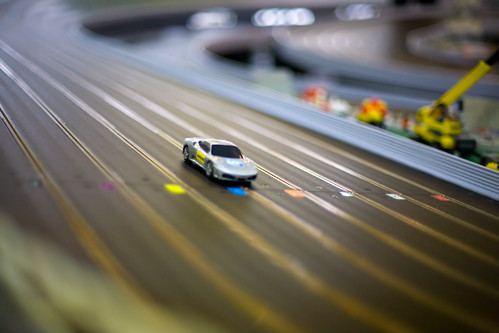
There wouldn’t have been a choice if we were living in the sixties. But as it is, slot car racers are polarized between sticking to the traditional system used by conventional slot cars and the modern appeal of digital slot cars. Here, we will walk you through the differences between the 2 types of slot cars. Let's begin.
Conventional Slot Cars Conventional slot cars are the traditional slot cars. These root from the earliest types of cars released during the 60s. As such, they pretty much pick up from the technologies used by their earlier predecessors and thus stick with the true slot cars. Although generally fun, conventional cars lack the same type of technology applied with its more modern cousins.
Digital Slot Cars Digital slot cars, on the other hand, are the new forms of slot cars. Among the notable differences between the types are the capacity of digital slot car tracks to allow several cars to race on 2-lane tracks (thus cars can change lanes during the course of the race), better manageability of the car during the race because of the integration of precise breaking systems (which are lacking with the conventional models) and the overall improved control over the car.
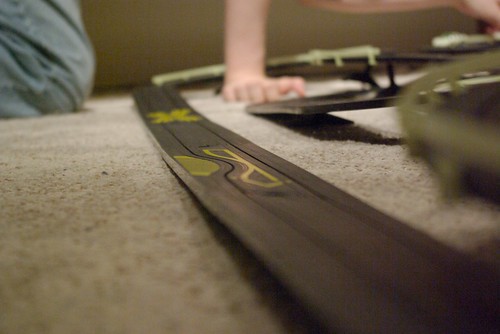
Surprisingly, despite the advantages offered by digital slot cars, most enthusiasts prefer the good old fashioned way of racing conventional cars. For some reason, the digital ones just don’t have the same appeal as their predecessors.
When choosing between conventional and digital slot cars, a few important factors should be considered.
Space: The amount of space you can use for your slot car track largely determines which type you should be using. Because conventional cars require individual lanes (remember they are stuck in the same lane during the entire course), the tracks they need require plenty of space. If you can afford space, you can go for conventional cars. If you can't, the digital ones can better suit you.
However, another major consideration with space is the number of drivers who would use the track. If you are just driving with your son as recreation, a conventional track may still work for you. Just use 2 lanes and you're good to drive traditional slot cars without worrying about taking up too much space. However, if other slot car drivers frequent your track, it is advisable to stick with digital cars. These are best for smaller spaces.
Cost: Slot car racing is a relatively expensive hobby. And its gets more expensive with digital slot cars.
In general, digital slot car sets and tracks are more expensive than the conventional sets. This is because there's just too much electronics involved. However, since you only need a set for a 2-lane track, you need not buy as much track as you would if you are building yourself a conventional track.
Complexity: Your skills as a driver are very important when choosing which type to buy. Digital slot cars need you to get over some learning curve as this will force you to learn the tricks of changing lanes among other things. With that said, it is way easier to drive conventional cars.
Other factors that you should consider are expandability of the racetrack, convertibility of the track as well as aftermarket value of your car, in case you are planning to sell your cars in the future.
Pages
-
2010
(25)
- July(15)
-
June(10)
- 4 Best Tips To Win In Slot Car Racing
- Your First Slot Car Race
- Types Of Slot Cars
- Invaluble Slot Cars And Slot Car Accessories
- How Slot Cars Became Popular
- The Fun Of Slot Cars
- A History Of Slot Cars
- Which Slot Car Controller Works For Different Kind...
- Four Tips To Getting More Out Of Your HO Slot Cars
- Conventional VS Digital Slot Cars
About Me
- Tim L
- Hi! I am interested in a LOT of things and love to blog on them. Check out my sites, hope you like them :)
